Things Started to Get Weird
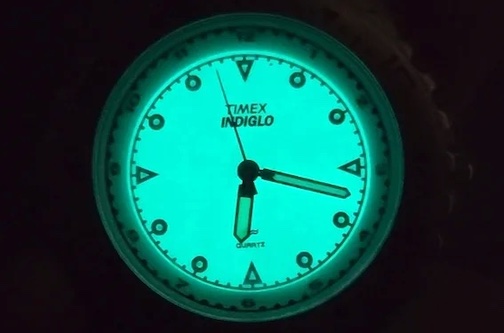
I’ve been putting this off. This post is not so much the result of something I am excited about as it is an obligation. I feel like I need to continue to sort out in my mind the background watches from recent decades that have led to today’s Timex divers. My Part 1, though tedious at times, came to me easier than this Part 2 is shaping up. I had been collecting and researching Timex dive-styles from the late ’60s to the early ’90s already. However, the products from about 1992-2015 have not been on my radar, as they say.
Timex, as big as it is, has always been adjusting to the changes in the industry, society and the economy, like everybody else. There are ups and downs over the long term. You could say Timex has been at a high point in the last 5-10 years? Timex has gone through lots of changes over the years. By 1990, the digital watch was the hot thing for the tech-minded, quartz was the standard and opened an inexpensive route for any company to market fashion watches as seasonal accessories. Mechanical watches were were in retreat or in specialty markets. Swatch had been going strong since the mid ’80s. Fossil was established and starting to dominate with their tin boxes.
Timex, by the mid ’80s, had started to get out of electronics, photography and computers and refocus on watches. Their biggest sellers were the Ironman sports digital watches. If we look at the 1990 Timex catalog, there are only 5 or 6 mechanical styles each, in men’s and women’s lines. A new Camper was available with new case and quartz movement, even though the classic mechanical was still hanging on.
I’m mainly concerned with the visual design and fashion experience of the watches rather than the materials, manufacturing processes and movement performance. The Timex of today is very different from the Timex of the ’90s.
Digi-Diver
In my Part 1, I sort of ignored the digital watches Timex was focusing on even though some had 100m or even 200m WR. I suppose now is the time to consider them as a diver-style watch. Digitals and Ana-digis were being made by Timex for outdoor sports in general to include boating and swimming. While several of the “sports” digitals were only 25m WR some were 50m WR like the classic Ironman, Triathalon or even 100m like the Atlantis below. I think up to 1985 the Timex digitals had a max of 50m WR. A 100m WR Ironman appeared in 1986, but it was not marketed at a diver.
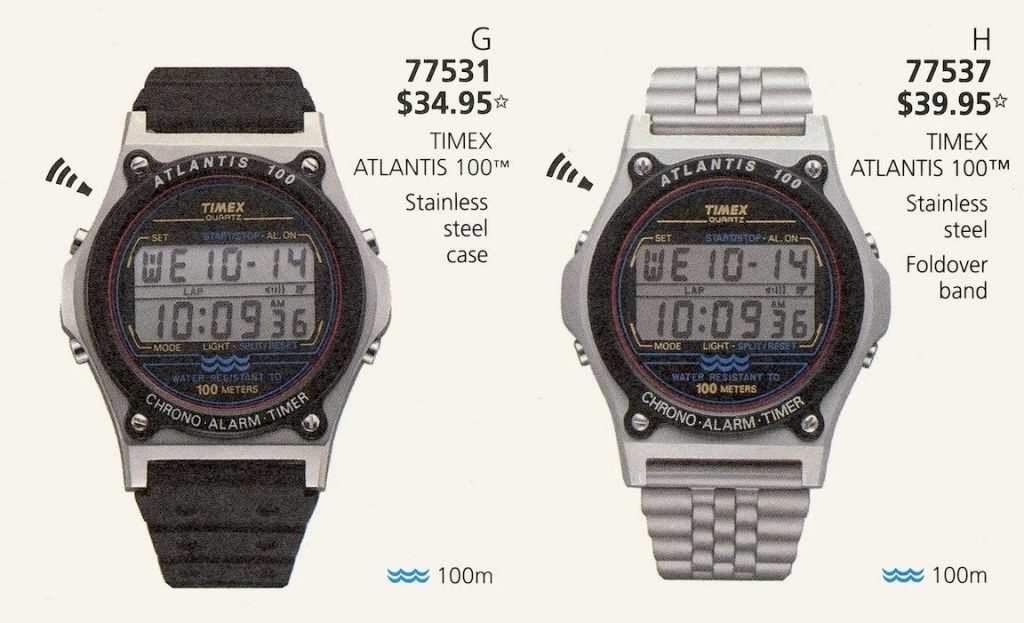
The Atlantis 77531 100m above actually goes all the way back to 1985 as a Marathon 77551. Starting in 1987 the name Atlantis appears. I’m not sure the difference, but probably had to do with electronic components. The overall build was the same. They were not called Diver-style in 1985. The name Atlantis surely contrives to evoke the watery world?
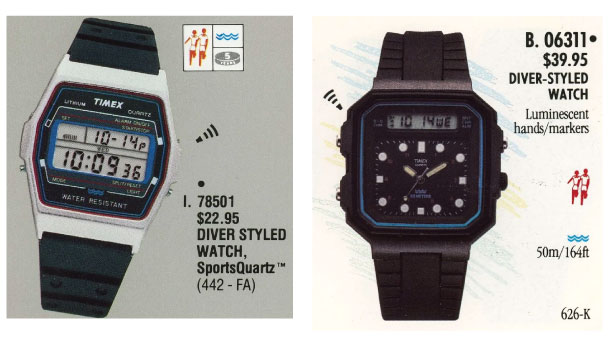
The reason I want to get into this topic of Diver-style versus Diver is because it highlights the marketing which can concentrate on either the specification or the fashion side of things. What makes the above 78501 digital and 06311 ana-digi a diver-styled watch? Is it because they used a silver metal case and a contrasting black rubber strap? Is it the dot hour markers? Its not the water resistance. The Atlantis with silver steel case and matching jubilee bracelet like a 00317 Diver is trying to get away form the black digital look with more traditional dive design cues.
Before I move on to more analog watches, there are some other products that really make me consider the consumer mood in the early 90s and the role of the wrist watch in general. Timex was banking on black plastic “sporty” digital watches with bright pops of color, that could accompany people on any outdoor activity, but at the same time not really pursuing the classic 200m diver.
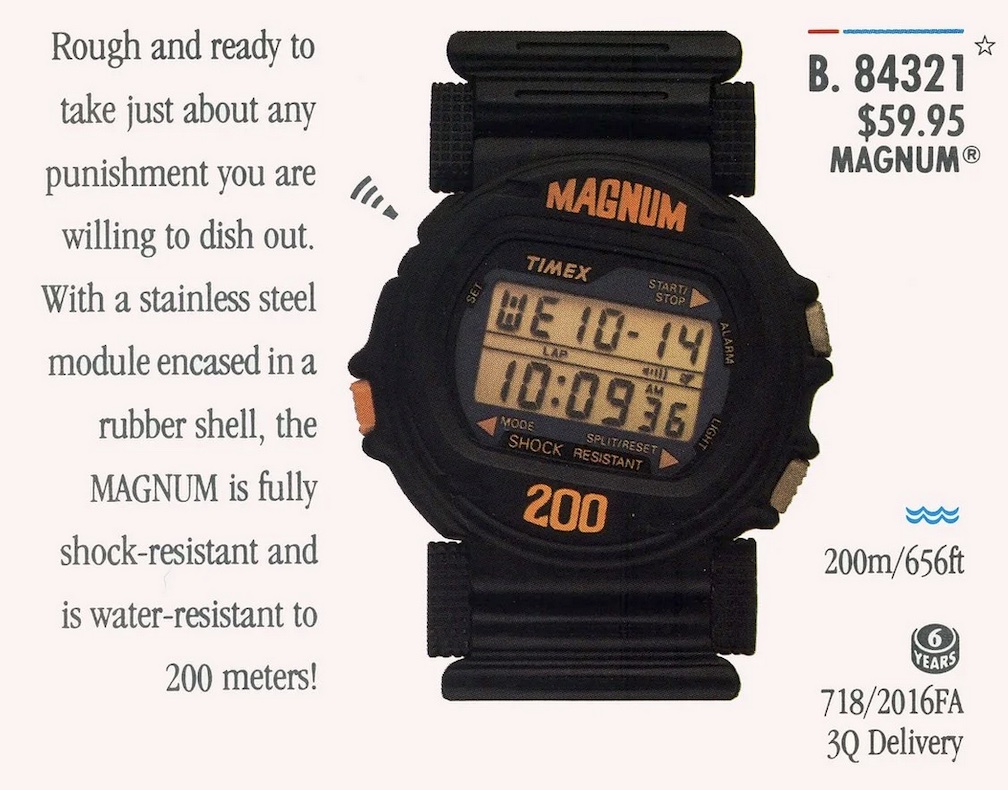
The above Magnum is interesting in that Timex never called it a diver or diver-style even though it was their only 200m watch? The 90s were the peak of Triathlon participation and Timex had a huge line up of Triathlon and Ironman watches. Timex watches probably were suffering from a lack of ruggedness so the Magnum was probably brought int to cover that heavy-duty ground? Later, by ’95 the Ironman was incorporating more durabilty.
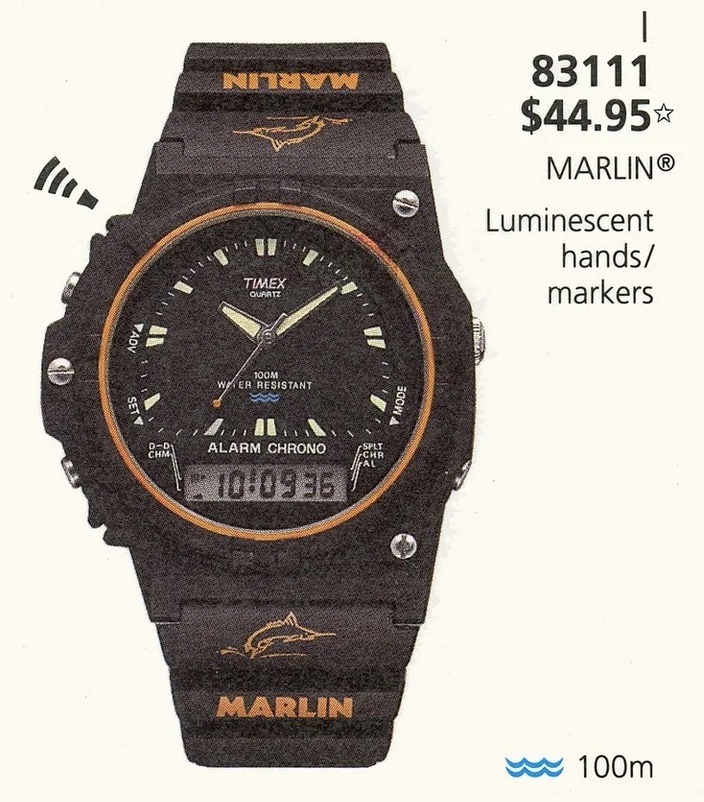
The Marlin analog-digital is an interesting watch to look a too. Having been in the lineup from 1989 to at least 1995, it takes the famous Timex name and even used the fish logo for a few years. I believe it was the first 100m ana-digi? It was never marketed as a dive-style. It has a very angular, asymmetrical, techy feel, somewhere between the Ironman and the Atlantis lines. Below is an ad from 1989 when launched.
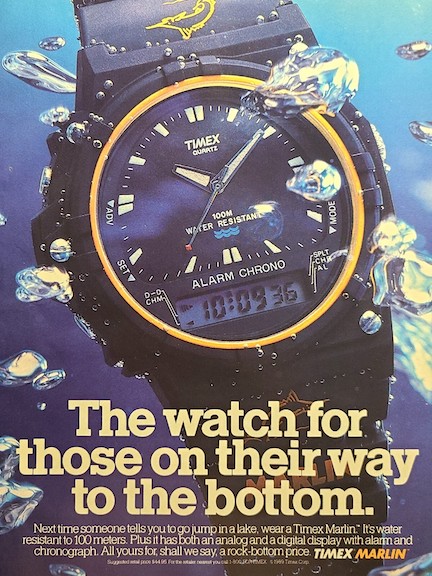
1991
Getting back to the analog lineup, the usual suspects returned, with a few changes as seen in the one 1991 catalog I have found. The catalogs usually start with the women’s categories. The women’s F1 copies are gone. But, there it is a new look for the titanium Tiny Tuna! Only in the women’s at this point? (This is odd because I have some men’s examples dated before this?) The 87911 last seen in 1989 is back as the 87927. It now has a metallic grey dial, titanium-like color with a light grid. There are gilt finishes on the hour markers and second hand. The unique rubber strap has been replaced by a tapering bracelet. It picked up a different movement, too; from a 654 to a 659.
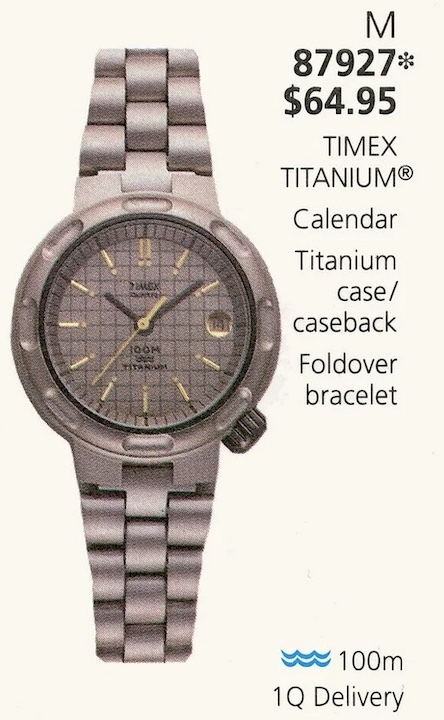
To follow up on the mention above about the men’s version of the titanium diver still showing the old look in this 1991 catalog; I have examples of the new look men’s gray/gilt with manufacture dates of 1988 and 1990. I suppose that reinforces how difficult it can be to date watches when catalogs can differ and production can start before catalogs are printed or models are announced. Anyway, its a cool little watch, and as I say, a candidate for reissue?
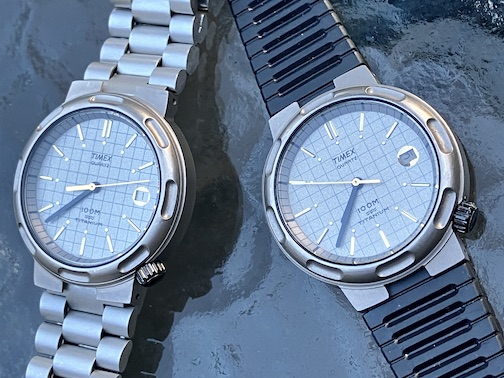
I’m not even sure what the new model number for the men’s is because I can’t find any info on it yet. The earlier version was the 31911. The changes really transformed the look and feel of the watch. Only the case is the same; the dial, hands, colors, strap are all different. The 24-hr numbers are gone. It went from sporty to more sophisticated. In the image above, the watch on left has the original bracelet while the one on the right has a replacement, non-Timex, rubber from the period.
As much as I like this watch, it does have some quirks. The first is the crown; it is so small and close to the lug that it is hard to grip and screw down. This may be one of the reasons, besides size, that it was only around for a few years. The bracelet seems to have no removable links? The only adjustment is the holes on the clasp.
The other divers continued on in 1991 like the classic looking woman’s 33911 50m and men’s 40511 100m which were discussed in Part 1. But in 1992 the 40511 got a new case back; it changed from a traditional screw-on to a flat plate with four small screws. ALong with that, the screw-in crown was gone. Those changes turned it into a 50m WR watch. It probably comes down to cost; the machined case backs are more expensive than the stamped ones?
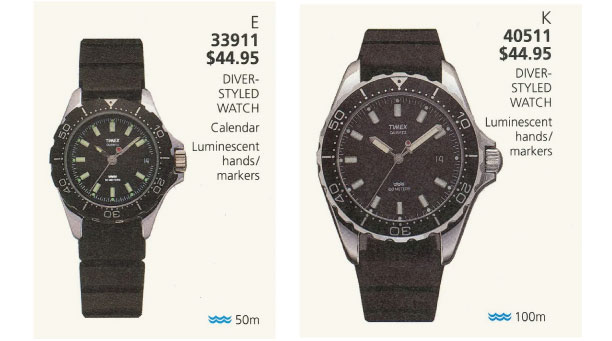
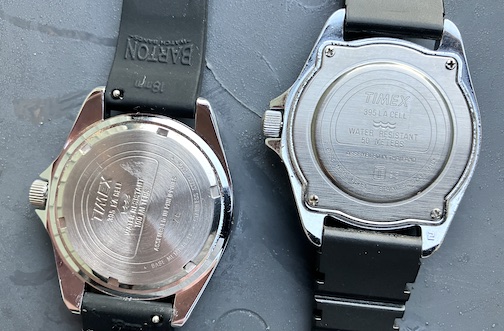
The Formula 1 look-alike, 15921, returns in one color for a bit longer. I mention it again because Timex calls it a diver-style even though it has a 30m WR rating. Just the black version shows in the 1991 catalog that I have seen. This style didn’t last long for Timex. I’m not sure if was the low water resistance rating of 30m, the look , legal pressure from Tag Heuer? Maybe people just figured if they wanted the 200m WR, they could get the real thing with better build quality? It was four years between the release of the Tag Heuer F1(1986) and the release of the Timex homage(1990). Maybe the buzz had worn off and you could get a used real F1?
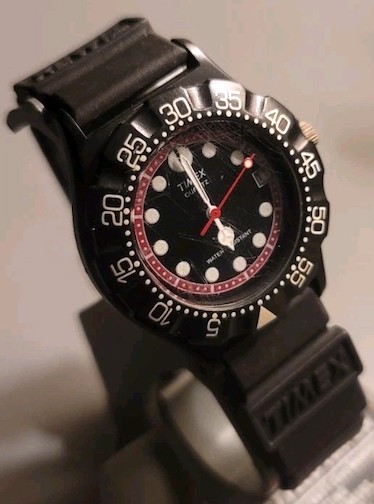
After reading more about the Tag Heuer F1 design, its purpose was to be a colorful, youth-oriented, entry level water sports watch. The F1 racing name was added later, after the design was set. Even though Timex dropped this homage, it made similar plastic watches with knobby bezels like the Action Sports of ’91-’92 that got up to 100m WR. There was also a 1994 Adventure ana-digi combo with similar bezel and 50m WR.
The more classic 00317 was still in the lineup with its matte finish case and bracelet. But, this look would not last for much longer. I think 1992 was the last year?
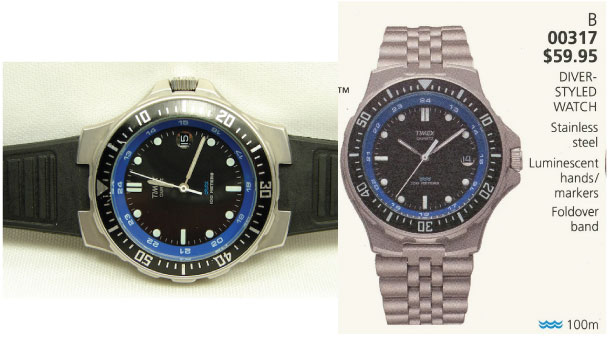
This conservative dial and hand style was on the way out to be replaced by bolder shapes and colors. Overall I like the look of the 003111/17, but the hands are a bit feeble looking? In the photo above the 00317 on the left has a replacement rubber strap that gives it the look of the 1988 00311. Once these bracelets had a problem years after purchase, you were not going to be able to get a replacement.
1992-93 Indiglo
This is the point where my source, Heritage1854.com, starts to dry up with US market catalogs. They have a 1992 France and no 1993 yet. Then, the continue with some ’94 an ’95, which are great. As I have said with just about any watch brand (except Tag Heuer), its really hard to find old catalogs on line. But, a lot of stuff is happening about this time with Timex. The big thing is the release of the first Indigo back-lit watches that lights up the whole dial. I think they were released in 1992 for Christmas season. At first, most models had an additional push-button to light up the dial before the switch was incorporated into the crown action.
This is a transitional period for Timex. Without a lot of supporting data or examples, other than just lots of scanning available catalogs and looking at hundreds of images online, I have a few general discussion points. Fashion watches were reaching their peak, gold is starting to appear more on watches, and the sports/training lifestyle is in full swing. But, as far as Timex is concerned, the classic diver is taking back seat to more generic digital multi-sport watches. I also feel the look of Timex is starting to mimic big brands like Tag Heuer, and Breitling. As we move into the mid 90s, on the non-digital side the watches get pretty weird looking, with flamboyant gold bezels and decoration. I’ll get into that later.
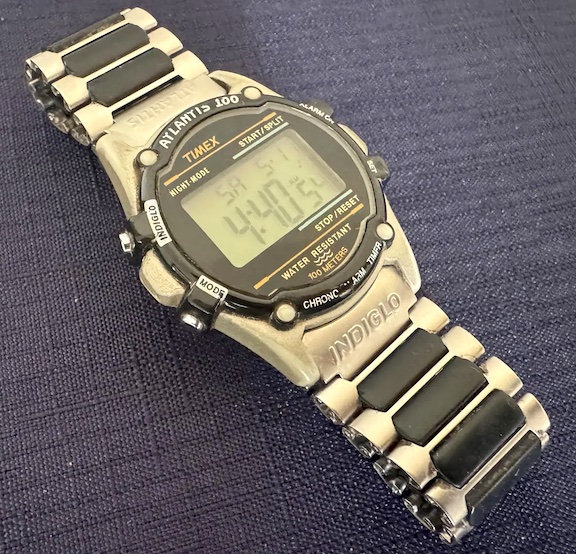
The above Atlantis shows a couple of details that makes me think it might be a 1993 version. It has the Indiglo word mark on the bracelet and has the metal and plastic bracelet style. Indiglo started appearing in ’93 and this type of bracelet started on the Ironman in ’90 but did not get to the Atlantis until ’92-93. They had the same jubilee type as the 00317 diver. I always liked the look of this type of bracelet. I wish Timex could continue it with better built version for their current watches.
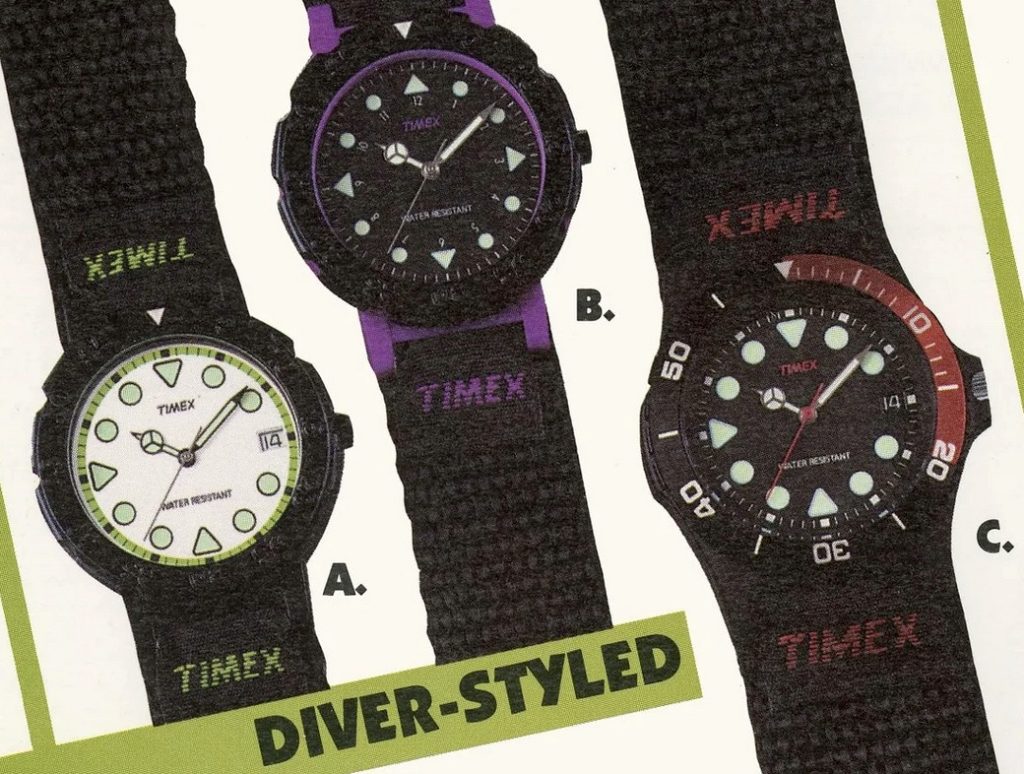
In the above image you see some very interesting looking watches. Taken from a 1991 catalog, they have decidedly Seiko-esque diver looking dials and even the Tag Heuer-like Mercedes hand set. They had plastic cases and bezels along with heavy weave fabric straps. They were all only 25m WR! They are part of a group of watches marketed under the name Action Sports, but were cheap and did not have the durability or water resistance of the Ironman type watches. They are in a way, similar to the F1 homage 15921 concept.
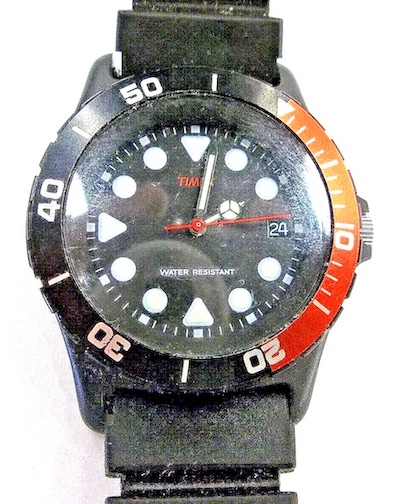
The above, uncommon, 1991 Action Sports 42921, 35mm, had only 25m WR. I think this look with a 38mm, better build, and 100m WR , like the 1993 40511, could have been a hit?
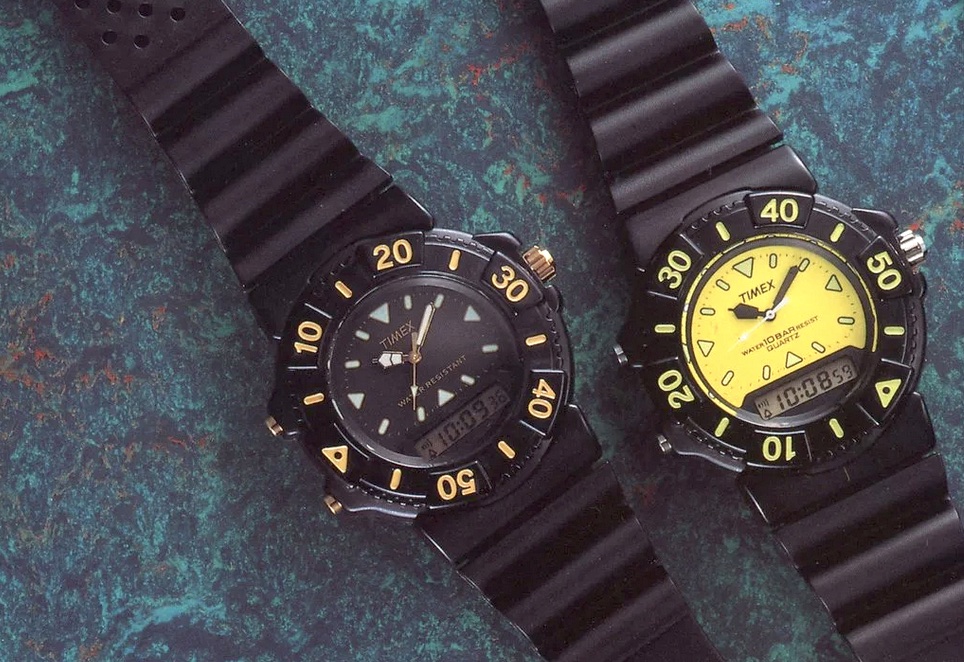
The Action Sports ana-digis above, 63911 and 63921 were upping the action with 100m WR. I also like these for some reason? Maybe its the contrasts and clearly diver feel? Again, these are models one doesn’t often see surviving in the wild. I think they were gone by 1993.
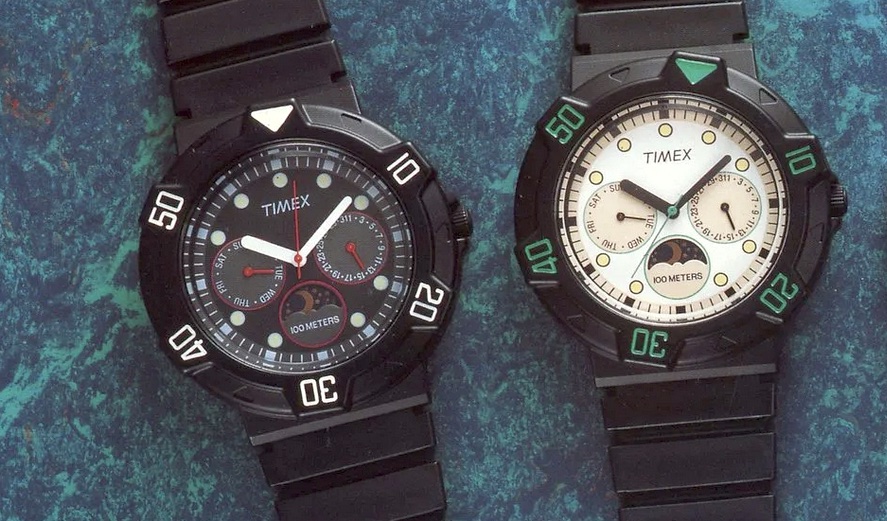
Another line that was something new in ’91-’92 was the Action Sports 3-eye, or Adventure 3-eye in some Euro catalogs. This complication with day and date in sub dials was popular in the ’90s from many brands. These were sporty, 100m watches, and had rotating bezels with big projections, but not called divers. They are another interesting concept that didn’t last?
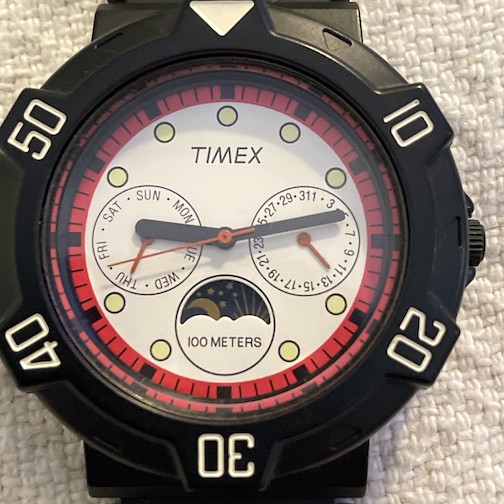
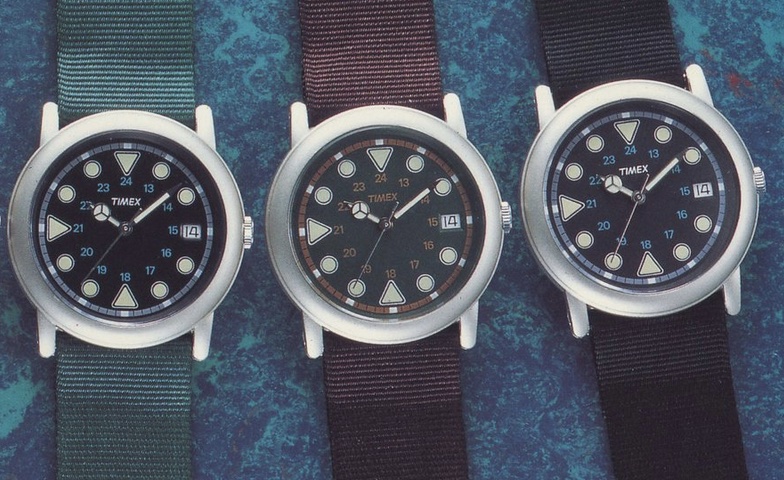
Along the lines of the Action Sports, I want to point out the dials in the image above taken from a 1992 French catalog. While considered a “camper” sub-group, because of the new quartz-camper plastic case with a matte silver metallic coating, and the pass-thru fabric strap, they have a very diver-like hour markers as well as an inner 24-hr track like a field watch. I think these were 25m WR watches, like the regular quartz-camper of the time.
The black-dialed, angular plastic case 40511 appeared in 1992-93, replacing the polished steel case 40511. This was quite a change when you look at several details. The case went from metal to plastic, the ratchet bezel changed to a friction bezel, a new dial design that added more lume took on the Seiko look. The bezel gets raised triagular tabs that protect the bezel insert and glass. The result was a very different watch. Even though I like the look of the new dial, the polished curves of the the older 40511 was classic vintage skin diver and was one of my favorites. I know of at least two examples of the the plastic case 40511 with a M902 movement to have the date wheel not advance over time. However this is not uncommon among several similar movements Timex used. It could be just wear /aging or various other maintenance needs of a 30-yr-old movement.
The new 40511 got bigger, from 38mm to 40mm, but the case change from a metal to a plastic is most noticeable. It did, however, go back to 100m WR from the ’92 50m.
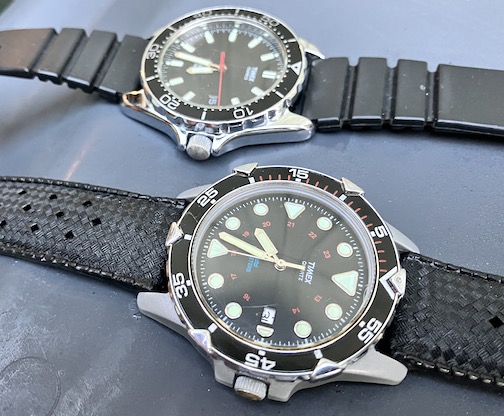
1994
Below is an interesting development in the Timex 100m Diver group that came about in 1994. Indiglo was introduced to a more traditional diver look.
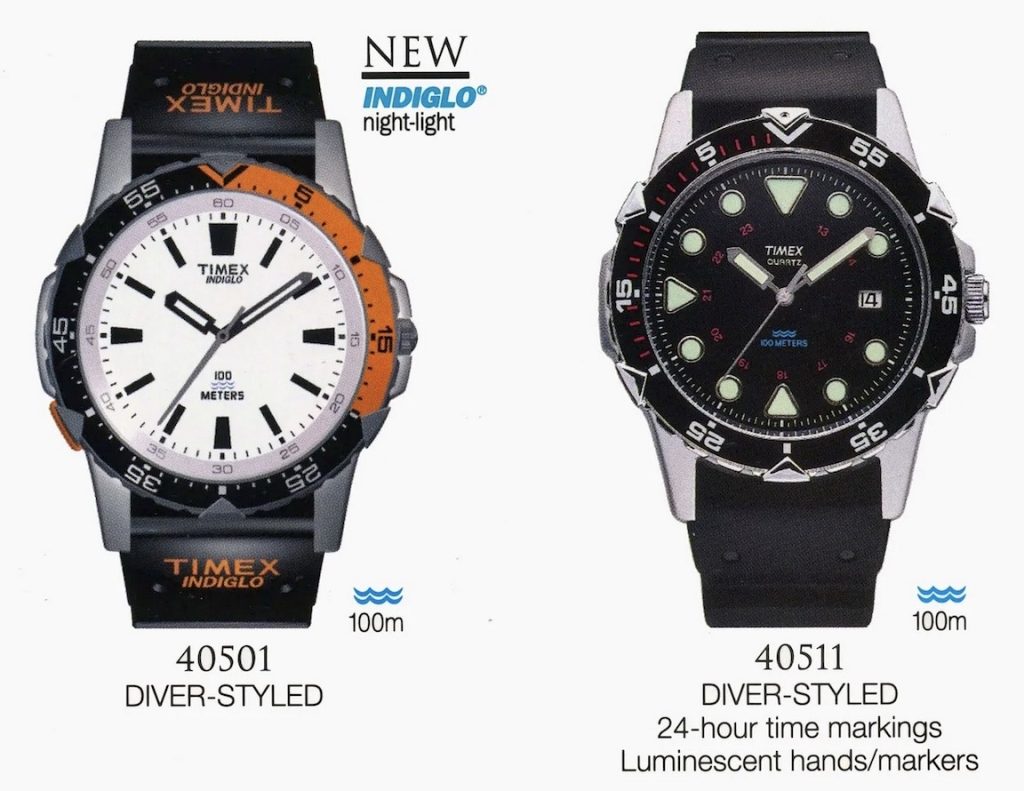
A new white-dialed, 40501 appeared in 1994. The white dial allowed the Indiglo back lighting to silhouette the black dial markers and hands. There was no lume on the makers or hands like in the black-dialed 40511. The back light was activated by a small orange button at 8 o’clock.
All said, the Timex classic diver look went away by 1994. Aside from the above mentioned 40501 and 40511, you had to look at digital watches like the Atlantis, Marlin and Ironman for 100m WR. Heck, even the 50m WR diver-style was about gone? A bunch of new looks with diver designs came in for women’s and men’s lines, but these new ones lacked the water watch specs; most coming in at 30m WR. So, they were not really divers.
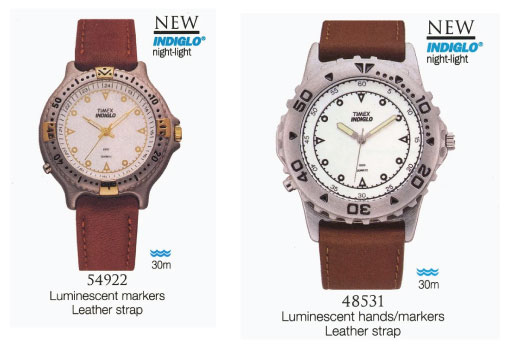
The above pair from the 1994 catalog show two new Indigo equipped models. Both the women’s and the men’s have a (thankfully) subdued light button at 8 o’clock. The bottom line is that Indiglo is still fun. But, it does take a hand action to push, while lume just takes a glance. The 54922 women’s has a very Tag Heuer look with the two-tone and dots on the bezel. The bezel’s ratcheted action is a bit crunchy. The men’s 48531 has a bezel that looks all business, but, both are 30m WR watches and come on leather straps. I think this is too bad, because I like the look of these. The hour markers are a little understated, but interesting, very graphic. They overall look reminds me of my beloved ’90s Bulova Marine Stars which were 100m watches. I put the women’s 54912 on a 16mm NATO to bulk it up a bit and its OK for my 6.75 in. wrist.
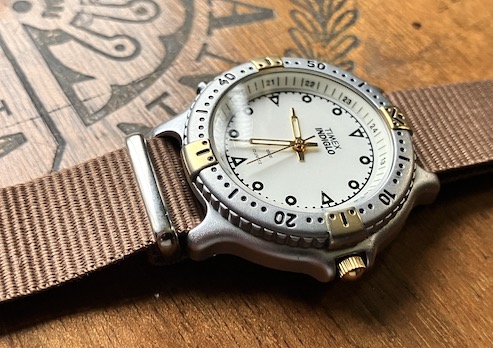
This brings me back to the subject of the fashion watch. I don’t want to go into all the different types of Timex watches at this time because I meant to stick to diver styles, but, there was an explosion of crazy diver/nautical looks and lots of gold appearing. Also, Timex was more concerned with incorporating Indiglo into its lines than focusing on the niche sport diver market.
There are some really weird watches in the 1994 catalog. Without showing images, there are fake skeletons, and elaborate gold bezels, and big combo ana-digis. There is a pair of round watches with the calendar months spelled out on the perimeter of dial at each hour marker, with no numbers on the dial and no pointer for the months? Just a Roman XII at top of dial. Then there are two new blacked-out analog chronographs, one with a white panda dial a tachy bezel and Breguet numbers? These examples below with blob bezels have me scratching my head? Look at the wavy line between the lugs.
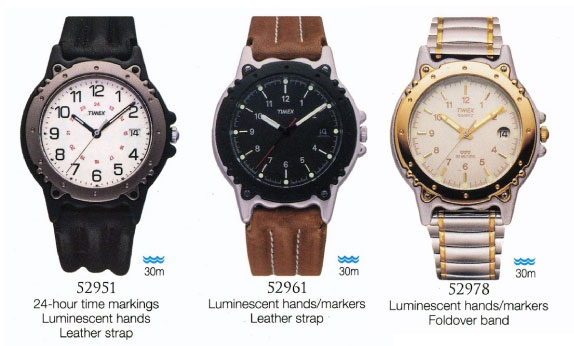
Another look the appeared about this time would continue for several years. It was this heavy, flat bezel look for several sporty, non-diver watches.
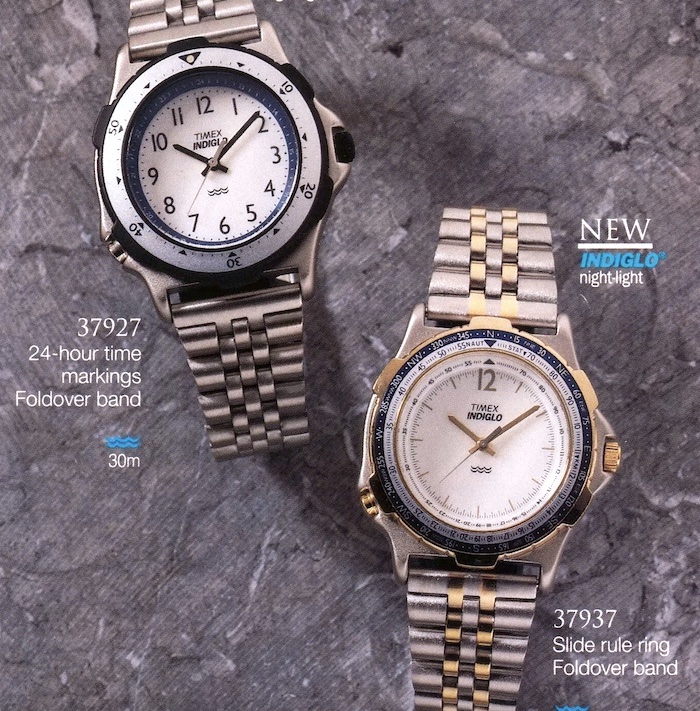
This wide, flat, rotating bezel look would prevail for a few years. The 37927 is called a 24-hour time; there are white 24. hr numbers on the dark rehaut around the dial and a count-up numbering on bezel. The 37927 is called a Slide Rule Ring! This is odd stuff for Timex? It has compass degrees and nautical or statute miles on bezel to line up with white inner bezel for whatever slide rule calculation you want to do. The dial has no numbers except the 12. Was Breitling the motivation?
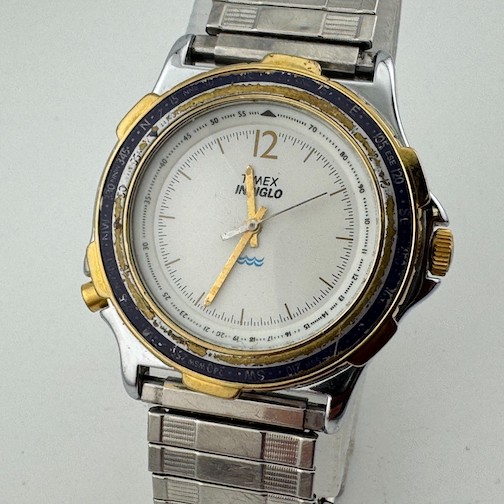
I had to show this above image of what a 31 yr-old Timex can look like! Compare this to the photo before and you can see most of the bezel printing has been scraped off and the original bracelet is gone. This is a good example of why when collecting old Timexes, condition is paramount. They were not meant to last or be repaired. Most of the ’80s and ’90s divers I have been mentioning in these posts are hard to find with original bracelets.
One watch I do like for some reason is this humble analog-digital combo 64707. It has strong Tag Heuer F1 vibes. The crisp white, knobby black bezel and blasted finish with jubilee bracelet looks purposeful. Too bad this didn’t get the Atlantis 100m WR build. I nominate this one, too, for a better built reissue.
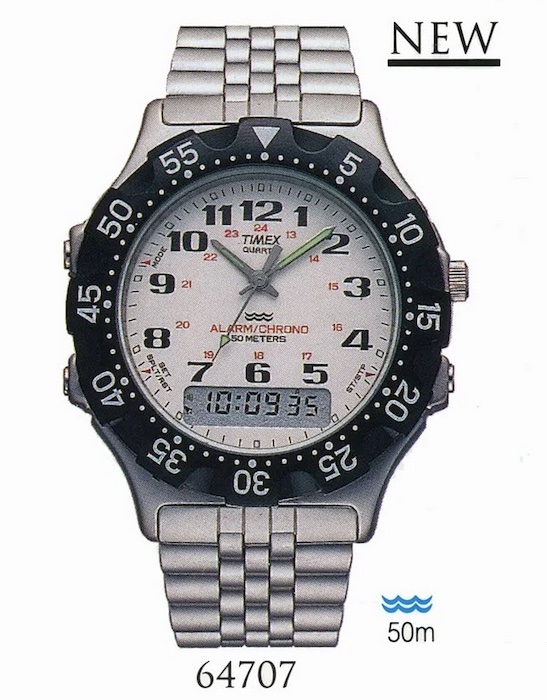
Five years ago I was not a fan of ana-digi watches, but they are growing on me. Having lived through the ’80s and ’90s while not being a watch enthusiast, I had no emotional attachment to the Casios I used. I found more joy with quartz analog fashion watches. I was happy to move away from digital watches as an older adult and fully embrace analog-only timepieces. When I started to get deep into watches again around 2010 and later I was still uninterested in digital watches, especially after becoming a smart phone user. Now, however, since studying the history of watches and collecting vintage and neo-vintage, I am discovering the charm of ana-digis, begrudgingly.
1995
I’m going to wrap this post up with 1995. Originally, I had planned to cover more years with Part 2, but, these posts just develop as I get into them. I got bogged down as I researched more about various models. A lot happened between ’91 and ’95 to the diver-style. Indiglo became the primary focus for Timex across all its lines.
’95 was pretty much a continuation of ’94 as many of the weird fashion styles and two-tone carried over. Some new nautical frosting appeared and some new water watches were introduced even though the Ironman style continued as Timex’s bread and butter. There were a couple of new developments in the diver-style.
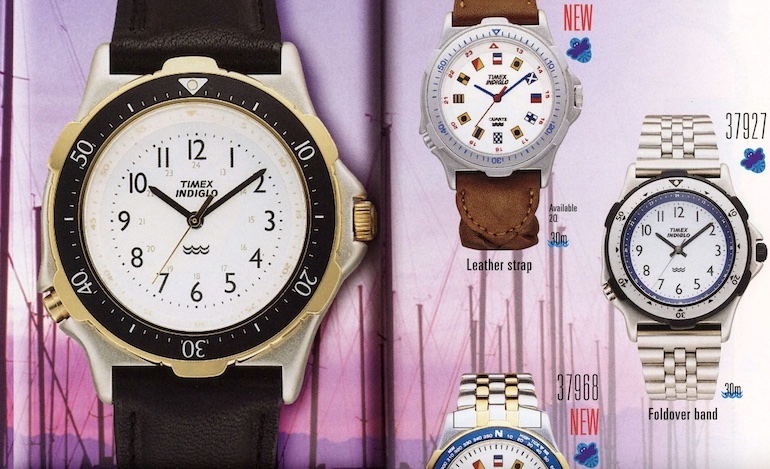
I took this slice of a ’95 catalog to briefly highlight the nautical theme many of the men’s and women’s were sporting. The bigger image of watch on left is the 37901, with dark bezel insert, which would be around for four years. The 37927 came out in ’94. The dials with the nautical signal flags spell out TIMEX INDIGLO! All are 30m WR watches.
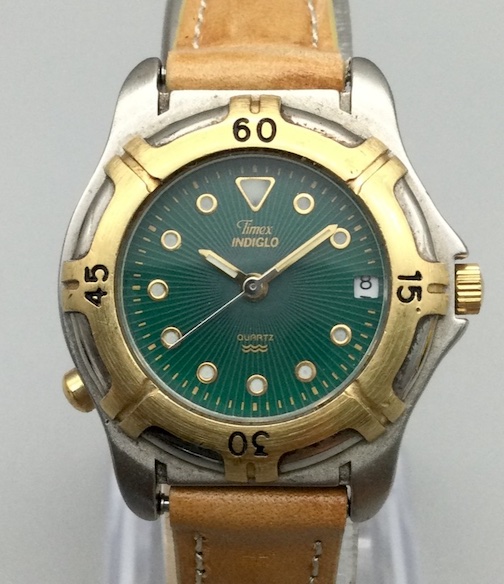
The above green-dialed 22922, women’s watch released in ’95 is one I wanted to point out. It could use a cleaning, but, I really like this look. The green sunburst dial, hour markers and gold bezel are great. Also notice the cursive Timex word mark. No men’s equivalent was made. If this was a little bigger, say 34mm, and had a bit more bezel detailing, like the women’s 54912 mentioned earlier, I’d be tempted to throw this on a NATO of some kind. I will wear a small watch. (I have a late ’40s-ealry ’50s DeFrece mechanical at only 29mm that I wear on a 16mmm canvas Haveston single-pass).
On the Indiglo Diver-style front there was something new in ’95. The 673s in the crudely edited images below deliver a new, very awkward, design.
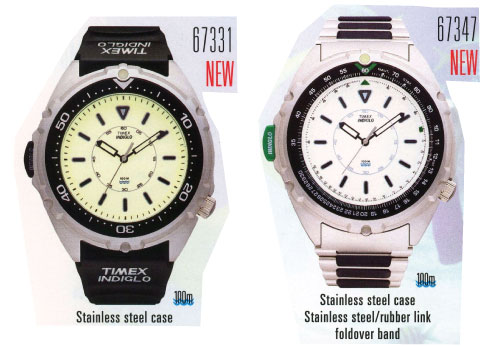
Now, I haven’t seen one of these in the metal, but, initially I have some mixed feelings. They look bad, but, apparently got a stainless case? If trying for sportiness, why not just do a steel version of the ’94 40501?! Both use the light-colored dial and black markers to take advantage of the back light, but the light button at 9 o’clock looks tacky. The 67331 has a standard looking count-up bezel, but the 67347 has a slide rule type bezel? The 67331 has a rubber strap with Indiglo logo on both sides. With the button and dial, that makes four places on the top side of the watch to have Indiglo printed, just in case you forget! The 67347 uses the metal/plastic combo bracelet(like Ironman and Atlantis) that I like, but then makes the Indiglo button green? Why the chronograph-like dial/bezel for a diver?
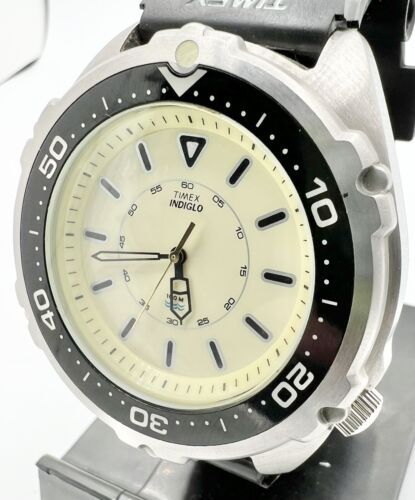
Let me quickly get away from the ugly 673s to talk about the ana-digi new addition for ’95. The 64707, discussed earlier, is back, as is the blacked-out 64351 that I have ignored because of its 30m WR. In addition there is a new Reef Gear ana-digi combo, the 67701, that gets back to looking like a proper diver. Unfortunately, it only has a 50m WR like the 64707. But, hey, its fun, and more along the lines of the F1 sporty theme.
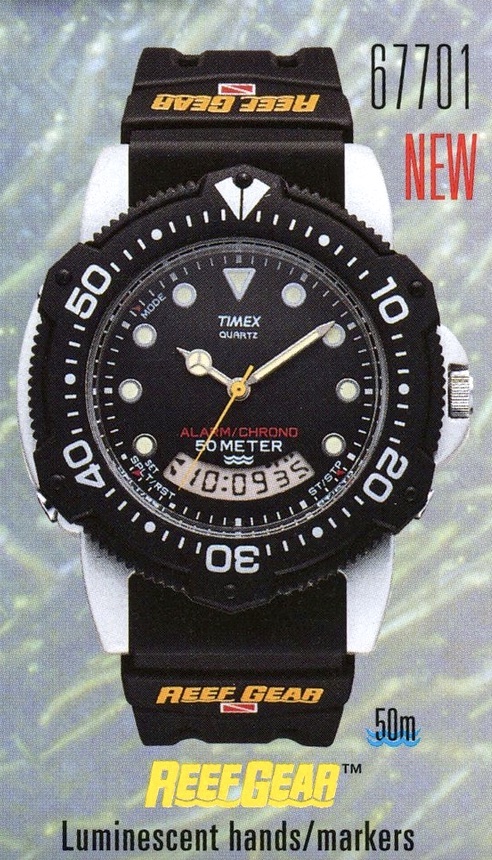
There’s a lot to like here; bold diver hour markers an Mercedes hands, big bezel, and the smiley digital window. No Indiglo here, just lume. Again I ask, if they could make some Action Sports watches in ’91 100m WR, why not this? Also of note, this might be the first use of Reef Gear as a specific sub-group? The future will bring us some interesting 200m Reef Gear divers.
Closing Thoughts
It’s been a wild ride from 1991 to 1995. I thought I would get through more years in this post, only to discover there was more to discuss than I first thought. As with a lot of Timex watches, there is not much recorded history to draw on for these studies. On top of that is the hard truth that being made as basically throw-away products, many Timex watches, if heavily used, do not survive to get passed on.
When I look back at ’91-’95 style I see a shift away from the classic diver in a move for a more modern look and ways to incorporate Indiglo. To me, the winners are the more classic 54922 and 48531 looks with more subtle light switch button. I just wish Timex had pushed for a 100m WR rating. The 40501 bridges that classic look with the new awkward looking 67331 and 67347. While the 40501 was able to incorporate 100m WR, Indiglo and still retain historical diver design cues, I still prefer the non-Indiglo 40511 with lume. For the years ahead, it seems Timex chose to go the back-lighting route over developing cost-effective use of lume. It would dictate the look of watches to come.
Again, I relied heavily on Heritage 1854 for its scanned catalogs. I have reached their limit. So, if anybody reading this has access to Timex catalogs from 1996 to 2010, drop me a note. Of course, there are many more knowledgeable Timex aficionados out there and many, many more Timex watches to touch upon, but I want to give my limited perspective on the evolution of the Timex diver. Most Timex watches never get discussed by watch enthusiasts.
Timex has always tried to give the most for the least amount of money. Even today, as their watches get better-made, there are still compromises to stay in the low end pricing. They have tried to offer a wide range of products to meet many needs while being responsive to the trends of the times.
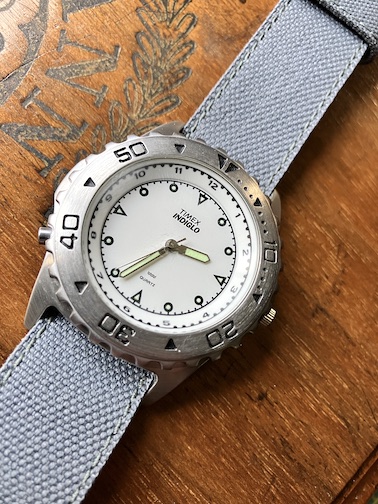

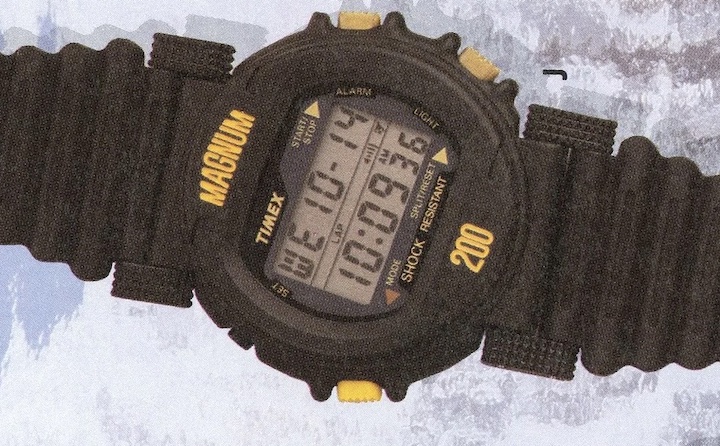
Leave a Reply